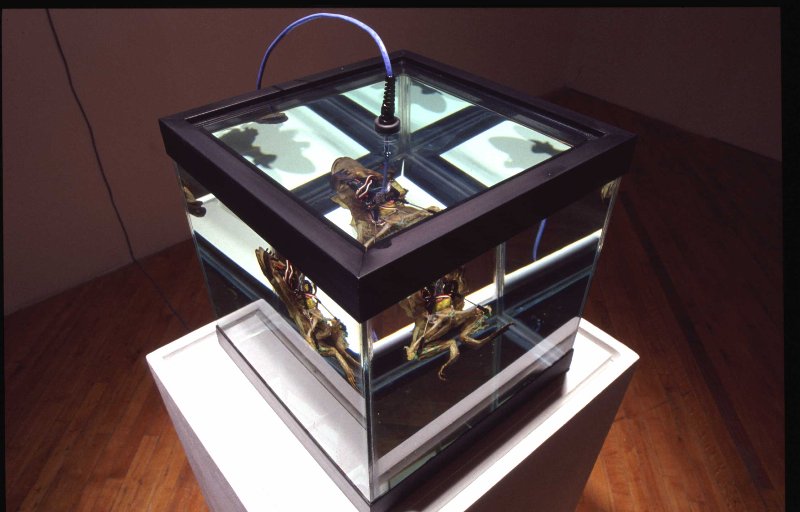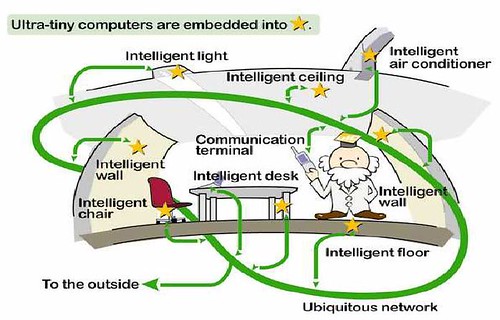Interweaving Mobile Games with Everyday Life by Marek Bell, Matthew Chalmers, Louise Barkhuus, Malcolm Hall, Scott Sherwood, Paul Tennent, Barry Brown, Duncan Rowland, Steve Benford, Mauricio Capra, Alistair Hampshire. To appear in Proc. ACM CHI 2006, Montreal, 2006.
An interesting evaluation of a location-based game, that has some good perspective related to higher-level concepts of pervasive gaming. I am less interested in the part about seamful design (less my area) than how a pervasive experience can be designed to interweave with patterns of everyday life. The authors adopted an ethnographic approach: interviews with each player, video clips of gameplay, a game diary that each player kept him/herself, and from system logs. Some excerpts:
relatively little has been reported about how location-based experiences actually vary with location or how a ubiquitous computing experience actually fits with other activities. This stands rather at odds with one ideal of ubiquitous computing, namely that it should be woven into the fabric of everyday life, to paraphrase Weiser’s Scientific American article.
(...) In the main trial, four teams played in three different urban areas in the UK (...) A few players found that their initial enthusiasm for the game dropped as the week progressed, (...) To understand why, we focus on three key issues in detail: the fit of the game with
patterns of everyday life, friendship and collaboration, and the impact of location.
(...)
we observed two general modes of play and several specific impacts on the patterns of everyday life. (...)The first mode was to change one’s patterns of everyday life by deliberately setting aside time for special, often relatively prolonged, game sessions, for example during the evening or weekends. (...) The second mode of play involved augmenting daily routines by interweaving the game with normal activities, most notably work and journeys, and consequently playing larger numbers of shorter turns
(...)
the game had some specific impacts on the patterns of their lives. The impact on work was a factor for many. Some gained an advantage by being able to play at work where WiFi was available, (...) Another notable feature was playing during journeys, especially to and from ‘town’ as part of the daily commute, to go shopping or to meet friends. (...) Several players also noted that playing the game in this way made them late for work, late getting home, or late for pre-arranged meetings depended on how much time the participants spent in the company of team–mates. (...) The game is most easily played walking around, but it was also played in cars, buses, trams and trains, and even when
bicycling
(...)
Another major factor in weaving the game into everyday life concerned friendships and opportunities for collaboration. (...) However, one aspect of collaborative play that could be problematic was getting team-mates together in the first place. (...) Successfully interweaving the game with everyday life also involved managing interactions with non–players including family, partners, colleagues and strangers.
(...)
In a game like Feeding Yoshi, play happens differently in different locations. Location was a major factor, both in terms of the distribution of open and secure WiFi access points across each city, and also in terms of which places felt good to play in and which felt bad.
(...)
Players also learned to interpret urban environments in ways that would help them play the game, on the basis of their ongoing understanding of the game’s technical characteristics, players’ practices and the game’s wider context. Inherent in the design process was an interest in using the existing ubicomp infrastructure as a resource for design and use, in a seamful wayinterweaving of play with patterns of everyday life.
And a good snippet for Fabien's research:
Players also became aware of some technical features that we were only vaguely aware of ourselves. In one case, a player became aware—and angry about—the fact that his PDA’s 802.11 antenna had a significantly lower sensitivity than his team–mates’, even though they were using the same model of PDA.
Why do I blog this? even though it's not related to location-awareness (my research topic), the idea raised in this article are very interesting, with regards to the relation between game usage and real life considerations.
















